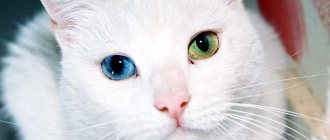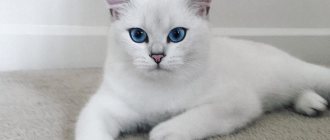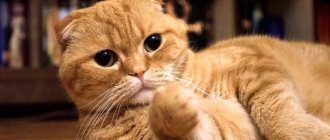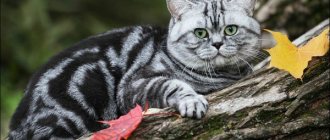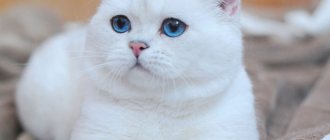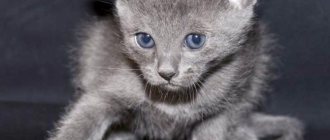The phenomenon of different eyes
Experts identify the following breeds of white fluffies that delight owners with their heterometry:
- The Turkish Van is a cat that glorified Turkey outside the country; a monument was even erected in its honor. “Fluffy” is distinguished by a gentle disposition and loving nature; to keep the animal in a great mood, it is enough to stroke the purr every day. The cat's fur is soft and velvety, so touching it is a real pleasure. The animal is faithful and devoted, directly clinging to members of its family, gratefully giving warmth for the care and attention provided. Like any other pet, it is important for the Van breed to choose one owner. By the way, the color of the fur can be very different, if the main color is white, inclusions can be red, black, blue and cream. In this breed, many kittens are born with one yellow eye and the other sky blue.
- A special white cat with different eyes, the Khao Mani is a breed bred in exotic Thailand. Even if a kitten is born with spots, after a couple of years they noticeably lighten or disappear altogether. Thoroughbred offspring are not cheap, but when you buy a luxurious beauty, you get a faithful friend who loves to take care of himself and is clean. Even the kings of Thailand admired khao mani. Seeing your pet for the first time, it is impossible to pass by the unusual eyes - one silver and the other golden. Don't be surprised if your kitty has trouble hearing - the gene responsible for heterochromia deprives most white cats of hearing in one ear, and on the blue eye side. The good news is that the animal’s vision is excellent.
- The Turkish Angora is a white cat with blue or multi-colored eyes. The character is good-natured, sociable, playful, the animal is capricious in food. Therefore, the owner needs to approach the selection of a diet for a furry cat especially carefully, respecting its pretentious tastes. The purebred animal has good immunity, which successfully fights viruses and bacteria without causing trouble to the purr and the owner.
Variegated eyes as a phenomenon has a scientific name - heterochromia (from the Greek heteros - “different”, chromos - “color”). Heterochromia, different pigmentation of the iris, results from varying concentrations of the pigment melanin and occurs in both animals and humans. Gender does not matter in this case, although according to statistics, females with this phenomenon are more common. Heterochromia is often inherited and does not affect visual acuity in any way. The most common combination of different eyes is blue and brown; in felinology it is called copper.
Content Rules
Most often, cats with heterochromia do not require special care or special conditions. They, like cats of any other breed, are taught routine and order from early childhood. Eating, resting and outdoor games should occur at a certain time. The kitten gets used to the established rhythm of life, which contributes to a mutually comfortable pastime.
An important factor is toilet training the animal. Kittens learn this from their mother by observing and inheriting her actions. If you have acquired a very tiny fluffy, you will have to take care of his good habits yourself. The pet must be placed in a tray with litter immediately after feeding. Purebred kittens are very smart and clean, so they quickly get used to relieving themselves in a certain place.
It is important that the tray is located in an accessible and safe place.
Kittens are naturally active and playful, but you don't always have time to have fun with them. The consequences of independent cat games can be torn curtains, torn wallpaper or furniture. To prevent this from happening, it is necessary to accustom the animal to the right games. First of all, you need to buy or build a scratching post for your pet yourself. From the many toys in the pet store, you are sure to choose something useful and attractive for your cat.
Despite the innate cleanliness and neatness, sooner or later the cat will have to be bathed. This procedure will be especially relevant for animals with white and long fur. It is necessary to accustom a kitten to water procedures from early childhood, then the process of adaptation will be quick and painless. The water should be at a comfortable temperature - about 30 degrees; only special shampoo can be used as a detergent. For long-haired breeds, it is advisable to use conditioner to prevent tangling and electrification of the coat.
A cat, being in a limited habitat, needs proper and balanced nutrition, which you must provide it with. It is very convenient to feed the animal with ready-made dry or wet food. To make the right choice, just consult a veterinarian and carefully read the instructions on the package. A prerequisite is compliance with the recommended dosage of food. If you think that your cat deserves exclusively fresh and natural products, then get ready to diversify his menu with products such as:
- fish;
- meat;
- dairy products;
- cereals;
- vegetables.
When composing your pet’s diet, you should take into account the breed, age, gender of the animal, health status, and even the time of year and temperature of the food. To keep cats comfortable at home, you need to take into account their physiological characteristics. If you do not plan to breed animals, then for convenience and your own peace of mind, it is recommended to sterilize them. This simple surgical procedure is performed in a veterinary clinic.
Sterilization has a positive effect on the character and behavior of the cat and even helps prevent certain diseases.
Japanese Bobtail
A striking representative of tailless cat breeds. It can be either short-haired or long-haired. Pure white bobtails are extremely rare. The most common color is bicolor - a snow-white body with black or red spots at the base of the tail or on the head. Bobtails are very agile, intelligent, and easy to train, so if you wish, it will be easy for you to teach your pet a couple of circus tricks.
Causes of heterochromia
This anomaly occurs not only in cats, but also in humans. This unique phenomenon is called heterochromia.
The reason that the irises of the eyes are colored different colors may be a lack of melanin in the body or, conversely, its excess amount. Melanin protects the skin from ultraviolet radiation. The color of the irises depends on how much melanin is contained and how it is distributed.
In complete heterochromia, one cat's eye is blue, while the other may be green, yellow or orange. Cats that have the W gene are genetically predisposed to this anomaly.
We still haven’t figured out exactly what heterochromia is. Is it a mutation or a gift that makes animals with different eyes seem even more attractive and mysterious? There are few reasons for heterochromia, but they all have a different nature. So:
- Genetic predisposition (many cats carry the white-haired gene in their DNA for many generations, and with it the gene for different eyes). Moreover, these genetic abnormalities can appear in any individual in any offspring;
- Past illnesses (very often the causes of such changes in the iris can be leukemia, various oncological diseases, etc.);
- One of the main causes of heterochromia is a lack of melanin pigment in the body, which is responsible for the color of the iris.
Interestingly, slightly less than half of cats diagnosed with heterochromia also have hearing problems. Usually this is deafness in one ear, sometimes in two. True, official veterinary statistics still reassure owners of odd-eyed cats. According to these data, about 70% of cats with heterochromia hear absolutely normally and this mutation does not cause them any problems.
And so it happens: two cats merge into one
There is another reason why a cat may have an extravagant color (like the two-faced cat Venus, for example) or eyes of different colors.
A rare phenomenon: a cat of a normal color with heterochromia
Cats are prolific animals. It occasionally happens that two fertilized eggs, instead of quietly and peacefully attaching to the wall of the uterus and developing further, merge into one. This results in one healthy, viable kitten, but with a double set of chromosomes. This phenomenon is called chimerism.
The fusion of embryos sounds quite creepy, but in fact, such animals live peacefully, bear offspring, and no one even suspects what an unusual creature they have sheltered at home. A cat cannot be considered a chimera only on the basis of a strange color; confirmation requires genetic tests (which no one is in a hurry to perform).
This cat's different colored eyes may be the result of an eye injury.
Mosaicism can also occur in cats - areas of cells with differences in DNA resulting from mutation. Mosaicism is often “to blame” for the appearance of areas of fur of “impossible color,” partial heterochromia of the eyes, and complete heterochromia in tortoiseshell and colored cats. The difference between a mosaic and a chimera is that mosaic mutations occurred on the basis of their own cells, while a chimera has two complete and different sets of chromosomes that have not undergone mutation.
It makes sense to suspect such deviations if the cat has eyes of different colors, but none of them are blue. For example, one is yellow or orange, the other is green. Also interesting are the variants of heterochromia in completely colored cats - this is much less common than in white animals, but it still happens!
Burmilla
Graceful aristocrats. These cats have long or short haired silver coats and expressive eyes of emerald or amber color. The breed standard does not include a perfectly white color - often the muzzle, back and tail of these cats are slightly darker than the color of the body. But this in no way spoils the beautiful Burmilla, making her even more unusual and attractive.
No matter what breed a white cat is, it is always gorgeous. In many countries, snow purrs are a symbol of peace, love and light. If you are going to buy yourself a purring pet, think about its white color. Such a cat will not only become the keeper of the hearth, but also your most faithful and devoted friend!
Mating
Puberty in Sphynx cats occurs at about one year of age. Before breeding an animal, it must be shown at an exhibition, in an open class, receive high marks and access to breeding. Usually, cats for breeding are sought through the club where your cat is registered. But you can also contact other city clubs. In nurseries, many producers are closed.
Mating will cost you 6,000 rubles and more. A Canadian Sphynx stud with a good pedigree, interesting color, and titles, costs much more. Mating with him will cost from 10 to 15 thousand rubles.
If your cat has not been shown and does not have a breeding assessment, then you will not find the owner of a breeding cat who will agree to breed his pet with your cat. As a rule, mating occurs without problems. The Canadian Sphynx accepts the “bride” on its territory. The instinct of procreation prevails over all others, and mating occurs successfully.
Due to the lack of fur in these animals, it is necessary to create a comfortable temperature in the room and trim the claws of both sphinxes, since skin damage if one of them is aggressive can be very serious.
If the mating was successful (failures are extremely rare among sphinxes), in about sixty-five days you will see charming babies.
Is a white cat with different colored eyes a special breed?
Not only purebred cats can be heterochromic; this phenomenon is also observed in outbred animals.
Many people mistakenly think that a white cat or a white cat with different eyes are representatives of some special breed. Indeed, among representatives of some breeds, for example, Turkish Van, Turkish Angora or Kao Mani, heterochromic individuals are very common.
But the British, the Scots, the Persians, the Maine Coons, the Rexes, and the most ordinary yard cats can all have different eyes. For example, the world-famous snow-white beauties with different eyes, Iris and Abis from St. Petersburg, are mongrel.
Are there such representatives among other breeds or outbreds?
Scottish Fold Cat
In the listed breeds, heterochromia is more common, but in other animals the appearance of this feature is also possible. Kittens with different colored eyes are found among:
- Scots;
- British Shorthair;
- Canadian sphinxes;
- Maine Coons;
- Persian cats.
Even a mongrel pet may have different eyes; they will be caused by a genetic mutation or changes that have occurred during life. From an esoteric point of view, such cats are considered carriers of pure energy and good luck, and therefore are highly valued.
Maine Coon
Cats of this breed are famous for their considerable size. They come in a variety of colors, with pure white being quite rare. In addition, according to the standard, only its ideally pure shade is allowed, without any color inclusions. At the same time, most snow Maine Coon kittens are born with colored spots on the head and body, which subsequently disappear completely. The white Maine Coon is gorgeous - its rich flowing coat is unusually soft and silky and at the same time requires no more care than wool of any other color. The main features of this breed are the presence of charming tassels on the cat’s ears and incredibly thick fur. Unfortunately, like most snow-white cats, white Maine Coons often suffer from deafness and heterochromia.
Deafness of odd-eyed cats
White cat with blue eyes: examples of breed names
Cats with white fur and blue eyes often suffer from deafness, and they have hearing problems from the moment of birth. Pets with different colored eyes are also prone to deafness. Scientists cite genetic disorders as the cause of this phenomenon. In the body of every animal there are 2 genes - one maternal and the other paternal. Moreover, if a gene responsible for deafness is passed from mother to child, but it is not passed on from father, then the former acts as the dominant one, which affects the kitten’s hearing problems.
Deaf animals are born that way right away.
The animal's ears contain organs that convert sound into electrical impulses that directly interact with the brain. In cases of a genetic defect, the transforming organ fails within a week after birth. And since in healthy kittens the ear canal opens only 1-2 weeks after birth, an animal with this genetic defect will not be able to hear a single sound in its entire life.
For your information! This gene also affects the animal's eyes, as a result of which the cat begins to see worse at night, which makes it a less effective hunter. As with other deaf animals, cats are prone to accidents, raise their voices more often, and are more aggressive.
Khao Mani
Another white cat with different eyes is Khao Mani. Kittens of this breed are commonly called “diamond eyes.” This breed of cat was bred in Thailand by order of the royal families, so the price of Khao Mani is quite high, and not everyone can buy it. This is especially true for representatives of the breed with different eyes. Thais are convinced that an odd-eyed cat can bring wealth, good luck and peace with tranquility to the house.
Khao Mani are short-haired cats with a small body size. Their main feature is the fear of loneliness, so they are extremely active and friendly. Cleanliness is also a hallmark of this breed, making them easy to care for.
From this video you will learn about the characteristics of the Khao Mani cat breed and how to care for them.
Feeding
Sphynx kittens need complementary feeding from the age of four weeks. And this is even if they are still receiving breast milk. For complementary feeding, boiled, well-chopped beef and cottage cheese are suitable.
From one and a half months you can start giving eggs, pate, pre-soaked dry food for kittens. Up to three months, babies are fed at least six times a day. In the fourth month of life, fish and cereals, as well as fresh herbs, are introduced into the diet. From six months the kitten can be switched to three meals a day, and by nine months - to two meals a day. Smoked meats and pork are strictly contraindicated for the little sphinx.
Scottish lop-eared
Scottish Folds are very similar in appearance to the British. White coloring, extremely blue eyes and heterochemistry are just as characteristic of the Scots as their British counterparts. However, their distinctive feature - drooping ears - is absent among representatives of British breeds. Cats of this breed boast a luxurious plush coat with a thick, soft undercoat. These are typical couch potatoes who love to bask in warmth and comfort. At the same time, they are characterized by considerable independence. These purrs get along well with children and pets, will never refuse to play, but generally behave independently.
Monument to Beauty
Unusual beauty has a downside - many heterochromic animals have serious hearing problems.
Alas, cats with different eyes are often deaf - completely or partially. Moreover, in the latter case, the ear located on the side of the blue eye usually does not hear. The cause of such deafness is genetic, it is the result of the action of the white color gene W. Its dominant allele blocks not only the production of color pigment, but also the development of hearing aid cells. Fortunately, breeders are resisting, and quite successfully, the spread of deafness of this kind in the population.
In Turkey, near the largest alpine lake, Van, there is a monument to white, odd-eyed cats of the Van breed.
At the entrance to the city of Van, not far from the lake of the same name, there is a monument depicting a pair of white cats with different eyes. This is very symbolic, and not only because the Turkish Van is a native breed of these places, but also because Van cats, unlike many of their counterparts, are calm about water and even swim beautifully and catch fish deftly. The Van breed has been declared a national treasure, and its image is embossed on a coin.
Interesting facts about the breed
Some interesting facts to better understand these magnificent animals:
- most Angoras are not afraid of water; on the contrary, they love to swim;
- The appearance of angora dogs in Russia occurred at the end of the 18th century; several animals were presented to Empress Catherine II, at which time fame began to spread about the extraordinary fur of these animals. They were carded, and gloves and stockings were knitted from the wool.
- Despite their dislike of being held, Angora cats are dependent on human communication and have a hard time with separation. No matter what color the Angora cat is, it is always the standard of elegance and grace, an excellent companion and home decoration.
Exotic
In many of their external characteristics, exotics are similar to the Persian cat, and this is not surprising, since these funny purrs with a “cute” expression on their faces are their direct descendants. The main distinguishing feature of the breed is their funny, slightly turned up snub nose. The snow color of the exotic is very rare and therefore very valuable. Their short fur, reaching no more than a couple of centimeters in length, is very soft and thick. It is difficult to find a calmer and more docile animal than this “plush” pussy.
How to choose a kitten
First of all, look at the conditions in which adult animals are kept and how well-groomed the kids are. Be sure to pay attention to their psyche and compliance with standards. If at least one of the listed points causes you doubts, do not rush to buy a baby.
The breeder must provide documents about the birth of the kitten - a breeding certificate (which is then changed to a pedigree in the club) or the pedigree itself. This document does not guarantee the animal a career at the exhibition and does not give the right to breed, but it does indicate the origin.
The Canadian Sphynx, whose price at three months of age is about $300, should be purchased from a well-established nursery or from experienced and conscientious breeders. Otherwise, you risk buying a non-purebred animal.
Importance for pet health
Pets with different eyes are considered healthy, since this phenomenon does not affect vision. Heterochromia is most common in white and calico cats. Also, 30% of cats with this anomaly have hearing problems, specifically in the blue eye. The rest of the cats do not have any health problems, and white cats have excellent immunity.
If you are the owner of a pet with different eyes, then it is important to pay attention to some nuances. If the blue eye turns red, then most likely a blood vessel or hematoma has burst. In this case, you should consult a doctor who will prescribe appropriate treatment. The color of the eyes may change if a tumor appears on the eyeball.
Pets do not need special care. Pay attention to the eyes so that they don’t turn sour. If purulent discharge appears in the inner corner, you should visit a veterinarian.
At what age can you determine the different eye colors of a kitten?
If previously heterochromia was considered a genetic anomaly and the appearance of such kittens was not welcomed, now everything is just the opposite. Breeders are struggling to unravel the genetic algorithms that are responsible for the eye color of cats, and kittens with heterochromia are desired and in demand.
But when kittens first open their eyes, they all have the same “baby” blue color.
This baby has one eye darker than the other - heterochromia may be suspected
The accumulation of pigment in the iris occurs gradually, and eye color changes with age. Heterochromia can be reliably determined at 2.5-3 months.
Experienced cat breeders, however, know that you can find out eye color even earlier. To do this, kittens are examined in a dark room with a weak light source. Blue eyes glow red, and the rest glow green.
This Turkish Van kitten is 1 month old - and it’s already clear that his eyes will be different colors
Save and increase
For a hundred years now, the Ankara Zoo has been running a program to breed white Angora cats with different or blue eyes.
At the beginning of the last century, unusual Angora cats found themselves in danger of extinction: the gene for long hair was actively used in the development of new breeds, and there were catastrophically few purebred Angoras left. In 1917, Turkey decided to preserve the breed as a national treasure, and for some time local animals were even prohibited from being exported abroad.
Now other white cats with different-colored eyes are bred in the world - and the British Shorthair breed is not lagging behind in this. For example, a nursery for odd-eyed Britons operates in Rotterdam.
British cat with multi-colored eyes, Riviums cattery
Character and psychology
The Turkish Angora is distinguished not only by its attractive appearance, but also by its social character.
The intelligent look of the Angora is not only an external characteristic. Turkish cats are really smart. With due diligence, it is possible to teach several commands, for example, to bring slippers, open and close the door.
The similarity with dogs is also manifested in the devotion of pets. The cat's love of love is enough for all family members. But the greatest affection will arise only for one person. Angora will be faithful to him until the end of her days. If separated for a long time, your furry friend may become withdrawn and lose his playful mood. The sensitivity of the Turkish woman is so strong that it helps to assess the state of mind of the owner. Adapt to it.
The Angora breed does not tend to sit for long periods of time in its hands. But the inherent desire is to be the center of attention. Angora is distinguished by non-standard cat sounds. No loud meows. The conversation consists of specific purring-uterine sounds. The cat will accompany them with almost all of its actions.
The sociable nature is evident even towards strangers. Angora welcomes you with Turkish hospitality
Every person will be treated with cat's attention
A calm mood easily gives way to a playful, robber state. Angoras easily make a mess. Of course, when you’re rushing around the apartment at the speed of light, it’s hard to notice what’s under your feet. More precisely under the paws. The breed definitely has a lot of energy. And love for tricks too. But for children, Turkish cats make excellent partners. Playing games together brings pleasure to both.
Good relationships also develop with other pets. But on condition that they recognize the Angora as the undisputed leader.
Hunting instincts manifest themselves in the desire to hide their treasures. The most unpredictable places are selected for this. Ambushing is also a favorite activity of the domestic predator.
What breeds is this phenomenon typical for?
Khao Mani
We already know why cats have different eyes, now let’s look at which breeds this phenomenon is typical for. White cats look the most elegant and, as they say, royally. In addition, the pink nose and pads on the paws add special sophistication to these graceful purrs.
The domestic cat Khao Mani is a special breed that was bred in Thailand. The name of the breed is translated as “diamond eye” or “white pearl”. Previously, these cats were kept at the royal court. They were believed to bring peace and good luck to the home. Only many centuries later did they become available to ordinary people.
Cats have a small body size, a slightly elongated muzzle, and short hair. It happens that a kitten at birth has spots on its white fur. Over time, these spots disappear and it becomes completely white.
Buying such an exotic pet will not be cheap. But as a reward you will find a faithful friend, very clean. These beauties have unusual eyes: one is silver and the other is golden.
Turkish van
The animals have semi-long hair, an elongated body and strong limbs. The pussy is fluffy, very affectionate and tender. She loves to be petted by her owners. The animal literally follows on the heels of its owner. As soon as he sits down, she will immediately be in his arms and will faithfully look into his eyes to be stroked.
Pets enjoy conquering the “tops” of refrigerators and cabinets. They adore bath procedures to such an extent that they don’t mind swimming outside, even in a puddle. Pets are highly trainable. They offer their paw, follow the command “Sit!”, and bring objects in their teeth.
The pet's fur is soft and velvety. An amazingly loyal animal rewards its owners with warmth and loyalty for their care and attention. Despite the fact that they treat all family members well, they choose only one person as their owner.
The color of the cat of this breed is white. Against this background there may be red, black, blue and cream spots. Turkish Van kittens are often born with different eyes: one eye is yellow and the other is blue.
Angora cat
Another breed of cat with different eyes is the Angora. The color is white, it has multi-colored eyes. The animals are small, weighing on average about 5 kg. The head is wedge-shaped and has erect ears.
Angoras are very playful, kind and love to socialize. These temperamental pets love to be the center of attention. If the pet is left alone, then it is worth buying him a scratching post and interactive toys so that he can throw out his energy and not get bored in the absence of his owner. Murki are very smart and easy to train. It won't be difficult for them to master a few tricks.
During the shedding period, the pussy should be combed with a furminator. The purr needs to be accustomed to this procedure from childhood; the procedure is carried out once a week. If tangles form, then in the summer you can trim the beauty.
Albino cat personality
The character of an animal rarely depends on color. So albino cats may be no different from their colored counterparts. Although it is worth noting here that the albinism gene can affect the health of the animal, but this point is already associated with changes in behavior.
Albino cats may be highly sensitive to sounds and bright lights. They are more vulnerable and therefore need attention and care. Such cats can follow their owner everywhere and get nervous if he is not nearby. In unusual situations (when moving, new animals and small children appearing in the family), albino cats can experience extreme stress.
We recommend the article: Why does my cat's belly sag?
Albinos can be more cowardly. If guests come to the house, they prefer to hide. Other cats may dominate them. Such animals are very anxious and modest. At the same time, they can be quite intrusive towards their owner, as they need increased attention.
What happens if you have a white cat at home?
Odd-eyed cats, as a rule, are highly valued, and if you plan to acquire such an animal, be prepared to shell out a large sum. It would also be useful to remind you that the eye color of kittens is established only by 5–6 months. If a kitten is born with heterochromia, then the different eye colors become noticeable at the age of 3–4 months. Therefore, when buying a kitten in an unreliable place and without documents, the seller’s assurances that the baby’s eyes will later become different colors may well turn out to be a deception - you will not be able to check this in advance.
What is the name of the breed of cats with different eyes and a snow-white coat? Such photos can very often be found on the Internet - most of them show off Kao Mani, Turkish Angora, Persians and some other breeds, including mestizos. Let's take a closer look at each.
Khao mani
Khao Mani cats, White Gem Cattery
The Khao Mani is a native breed of Thailand. This flexible, completely white cat with an athletic build was very popular in high society and was known as a favorite of royalty. Despite a history dating back several hundred years, the breed was registered only in 2009, and the CFA standard appeared on the official website of the Cat Fanciers Association only in 2018.
To this day, the breed is considered very rare; there are no Kao Mani nurseries in Russia yet. According to the standard, a Khao Mani cat can only be white with eyes of a bright pure color of any shade - from blue to copper, including multi-colored eyes.
By entering “Kao Mani” into the search bar, you can see a large number of photographs of the odd-eyed Kao Mani, although such cats are not very often born within the breed.
Turkish Angora
Despite the fact that a large number of different colors are recognized as the Angora standard, it is the white odd-eyed cat of the Turkish Angora breed that is considered the national treasure of Turkey - to this day, a joint program of the Turkish government and the Ankara Zoo for breeding odd-eyed white Angoras operates in this country.
The Turkish Angora is incredibly beautiful, inquisitive and playful. The semi-long snow-white coat of the Angora does not require too much grooming. Angoras with different eyes will have one eye blue and the other green, golden-green or amber.
Turkish van
Turkish Van cat, photo by Lyudmila Pankova (Tessa.lv)
This is an indigenous semi-long-haired cat breed that descends from animals that lived in the area near the Turkish Lake Van. These cats have a very characteristic unique color, which is called “Van”. At least 80% of the surface of the cat’s body should be white, and only the tail should be red-chestnut with the usual rings, and spots of the same color on the face and back near the shoulder.
The classic color of Vans is red, but black, blue, tortoiseshell and cream are also acceptable. A cat with different eyes of the Van breed is not so rare; in this case, a blue eye will be complemented by an amber one.
Oriental
Orientals are unlike any other breed, and looking at them, it is easy to wonder if they are even cats. An elongated, muscular body with long slender limbs, huge ears, a long muzzle and elongated eyes, as if squinting - this is how you can describe a typical representative of this breed.
Add to the extravagant appearance a friendly, playful character and complete intolerance of loneliness, and you will get a great companion cat.
In cats with different colored eyes of the Oriental breed, one eye will be blue and the other bright green, because this is the color that is most characteristic of it, although among other breeds the variation of blue and yellow or blue and orange/copper is more common.
The Persian cat, known since ancient times, and its close relative, the exotic cat, have much in common in their breed standards, with the possible exception of the texture and length of the coat.
Persian cat, CH PL Bagira Vivaldi Legacy
The long, thin and very fluffy coat of Persians requires very careful and competent care, while exotics sport a short, thick and plush to the touch coat. That is why exotics are called Persians for the lazy.
Exotic breed cat, Toxicate cattery
There are also differences in character - Persians are considered relatively calm and balanced creatures, although with a certain temper. And exotics are exceptionally gentle and friendly with their owner - their charming appearance fully corresponds to their flexible character.
As for odd-eyed white Persians and exotics, the standard is to pair a blue eye with an eye of a deep dark orange or copper shade.
Perhaps both of these breeds are the most popular both in Russia and throughout the world, due to their beautiful appearance, ease of care and calm, independent character.
British breed cat
And although the most common color among the British and Scots is blue, the snow-white representatives of these breeds look especially impressive. It is these cats that have eyes of different colors - blue in combination with gold or the color of dark copper.
Scottish cat, Timosha cattery
Rex cat breeds with curly fur are called. These include the Cornish Rex, Devon Rex, Selkirk Rex, Ural Rex and La Permian. All these breeds have a huge variety of colors and eye colors. Among animals with a solid white color, there are individuals with multi-colored eyes, when one eye is blue and the other is yellow, gold or green of different shades.
Devon Rex cat, photo Irene McCullagh
There is an opinion that people are divided into two types: some categorically do not perceive sphinxes or treat them with bewilderment, while others cannot live without hairless cats and do not even want to think about any other “normal” representatives of the feline family. Only one thing is absolutely clear: the Sphinx will not leave anyone indifferent. The shocking appearance is complemented by a peaceful character, and sphinxes are perfectly trainable.
The Sphynx standards recognize all colors, including white, and the large lemon-shaped eyes can also be of any color. Sometimes white sphinxes have different colored eyes - blue and yellow or green.
What canned food tastes best for cats?
RESEARCH ATTENTION! You and your cat can take part in it! If you live in Moscow or the Moscow region and are ready to regularly observe how and how much your cat eats, and also remember to write it all down, you will receive FREE SET OF WET FOOD.
Project for 3–4 months. Organizer - Petkorm LLC.
Want to participate? Call!
There is no single, specially bred breed of white cats with different eyes. Divergence of eyes occurs in British, Devon Rex, Maine Coon, Scottish and others. However, there are lucky people for whom heterochromia is most typical.
The breed is named after the Van district in Turkey. Very active and cheerful cats, quickly making contact with people and becoming tame. Their color can be not only pure white, but also tortoiseshell - have inclusions of golden, brown, gray, black. The eyes are usually different - yellow-blue. Animal fur is so soft and pleasant to the touch that the desire to stroke it arises in absolutely everyone who touches it.
Cats are extremely sociable and literally follow on the heels of their owner. Looking languidly into their eyes, they do not miss any opportunity to jump on their hands or knees. They love heights and easily climb the “tops” of refrigerators, cabinets and mezzanines. They also do not refuse to take water treatments, enjoying swimming in the bathtubs or exploring street puddles. They respond quite well to training, quickly learning commands such as “give paw”, “sit”, “fetch”, etc.
We invite you to read: Changes in color in cats: causes and correction. Manifestations of hyperpigmentation reaction. Other reasons for color changes
Another breed of white cats with different eyes. Named after the Byzantine city of Angora, from where it was later brought to Europe. With a rather elegant physique and low weight (3-4 kg), cats are distinguished by well-developed muscles and a stable immune system. The fur is long, soft and fluffy, but has virtually no undercoat.
In addition to the classic color, the beautiful Turkish dog can have cream, marbled and even black coat, but white is still considered the standard. The vulnerable point of the Angora, like other cats with different eyes, is the tendency to deafness. However, this defect is perfectly compensated by its devotion to one owner, as well as its peacefulness and tolerant attitude towards other pets (dogs, birds, rodents). They are quite picky about food, so the diet must be selected very carefully.
Khao Mani
The homeland of this breed of cats with different eyes is Thailand. Translated, Khao Mani sounds like “diamond eye” or “white pearl”. Initially, cats were kept only at the royal court, and only many centuries later did they become available to ordinary people. Although the price for representatives of the cat world still remains very high, so not everyone can afford to keep them at home.
The animals have smooth short hair, a small body size and a slightly elongated muzzle. By temperament they are sociable, friendly and affectionate. They are unpretentious in maintenance and extremely clean, so they are easy to care for. Pathologically they cannot be alone, preferring to always remain in the center of attention. They are believed to bring peace and good luck to the home.
And the last thing I would like to note that white cats have in common is their ability to be a true friend and partner for life.
If the eye becomes not even blue, but for example a reddish color, then this is most likely a bruise. In this case, you need to urgently contact a good veterinarian. This may turn out to be a simple hematoma or a burst vessel. But the diagnosis is not always so easy to make. For example, a change in eye color may indicate the growth of melanoma or some other foreign formation in the fundus or apple.
Breeds that may have heterochromia
Not all cats with white fur experience this phenomenon, and its occurrence is 100% impossible to predict. Breeders tried to breed a separate breed, but they failed. Of particular value are those babies in whom heterochromia has been observed in several generations. This is possible in Turkish Vans, Angora cats and representatives of the Kao-Mani breed.
Turkish Angora
The breed got its name from the Byzantine city of Angora, which is its homeland. These cats came to Europe in the 16th century. There is an opinion that it is its representatives who are most predisposed to heterochromia. Most Angora cats have white fur, less often marbled or creamy. However, you can find individuals of black, red or even blue color.
This is an elegant medium-sized animal, weighing about 4 kg. Has long erect ears. The coat is almost without undercoat, but is delicate, soft and fluffy. The disadvantage of the breed is considered to be a tendency to hearing loss.
The cat has a calm and docile character, gets along well with other pets, and is very attached to its owner.
Turkish van
The breed is named after the region of Turkey in which it was created. Individuals of this breed are quite large in size. The wool is not very long, but soft and pleasant to the touch. The color can be not only white; there are animals of various colors: tortoiseshell, with red, black, gray markings.
These cats are very playful and active, they have a well-developed hunting instinct. The Turkish Van is distinguished by its curiosity and sociability, and considers only one person to be its owner. Contrary to the well-known opinion that cats do not like to bathe, representatives of this breed do it with pleasure.
They are also easy to train and quickly learn simple commands.
There are breeds of cats for which heterochromia is not a pattern, but rather occurs as an exception. Animals are born albinos, and different colors of the irises of the eyes are a secondary sign of a genetic deviation. Heterochromia is extremely rare in the following breeds:
- British shorthair;
- Scottish Scottish or Highland;
- orientals;
- Persian cats;
- Maine Coons;
- Canadian Sphynxes;
- Devon Rex;
- Cornish Rex.
Khao mani
The breed originates from Thailand and was bred for the royal family. Even now, not everyone can afford to buy such a kitten because of its high price. The name translates as “diamond eye” or “white pearl”. It was believed that a white cat with different eyes attracts happiness, prosperity and good luck to the home. Therefore, even in the modern world, kao mani is treated with awe and adoration.
The animals are small in size and have short, silky fur. The slightly elongated muzzle, combined with a pink nose, makes the cat funny and cute. Some Khao Mani kittens are born with multi-colored spots, but as the individual grows older, the markings completely disappear. Cats of this breed are friendly and sociable, require constant attention from the owner and are afraid of loneliness.
Persian cat
Persians are considered the most common cats in the world. Since they come in different colors, the white ones with different colored eyes are a really great find. However, for such a find you need to pay twice as much.
Of course, it also happens that heterochromia occurs in other breeds, but this is more often explained by the fact that this has occurred to some extent as a gene mutation. Therefore, if you want to buy a white cat with different eyes, we advise you to choose one of the breeds listed in this article, or you can see what kind of white cat with blue eyes there is from several breeds.
Divine creatures
Humanity has surrounded the image of white cats with different eyes with numerous myths, legends and signs.
According to one legend, a white, odd-eyed cat of the Van breed saved Noah’s Ark from destruction by destroying a mouse that wanted to gnaw a hole in the ship. Christians also have a legend that a white cat warmed little Jesus in the cradle. And Muslims even allow cats to enter the mosque - in memory of Muezza, the white, odd-eyed favorite of the Prophet Muhammad, who once saved him from a snake bite. And the fact that cats always land on four paws, by the way, is considered a blessing from the prophet.
Anatomy of a cat's eyes
A cat's eyes are large compared to the size of its head. As described in the MSD Veterinary Manual, the bony cavity or socket that contains the eyeball is called the orbit. The eye socket is a structure made up of several bones. The orbit also contains muscles, nerves, blood vessels, and structures that produce and drain tears.
© shutterstock
The white of the eye is called the sclera, which is the tough outer layer covered by the conjunctiva (a thin membrane). This covers the inside of the eyelids. In front of the eye is the cornea, a transparent dome that protects the eye and allows light to pass through.
The iris is the round colored area of the eye behind which the lens is located. The retina lines the back of the eye and becomes sensitive to light. This is what turns light rays into nerve impulses. The retina sends rays to the brain, which converts them into an image.
Light enters through the pupils, which quickly respond to changes in light. In the sun, your eyes will become small. In the dark they will expand so the cat can see.
Snow Bengal
The short fur of this cat, even if it has a snow-white base, will still have rare colored spots or streaks. There are three varieties of snow-white Bengal:
- Lynx is the most “pure” and gentle. As they say, “whiter than white.” The color splashes on this cat's fur are absolutely invisible. Her eyes are a rich blue color. Lynx has no heterochromia or hearing impairment.
- Mink - its main color is almost white, the pattern present on the body is noticeably pronounced, the eyes are gray-blue, with a green tint.
- Sepia is a light-colored cat, but not white—the shade of her coat can rather be called honey. The eyes are purring with a slight yellowish tint or aquamarine color.
This breed is one of the most expensive snow-white breeds.
Types of odd eyes
According to the method of occurrence, heterochromacy in cats can be congenital or acquired.
According to the distribution of the iris of the eye, they are distinguished:
- full;
- sectoral;
- ring
Complete heterochromacy is when one iris of a cat is blue, and the other is any other color.
Sector discordance is determined by the fact that only some part of one or both irises is painted a different color.
Ring implies the presence on the iris of the eye of a kind of ring of a different color from the main color, usually along the edge.
